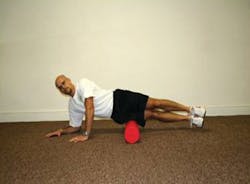You are three days into your four day stretch of 10 hour shifts. The weather has been cold, the call volume has been high and at this point your back is flat out sore. The shift ends and as you get home your back is getting consistently tighter. So like most folks you pop a couple of Motrin and chase them down with an adult beverage, climb into bed and hope that you feel better in the morning because you have to work tomorrow.
If this sounds familiar that’s because for many officers it is. Unfortunately we have been programmed to self-medicate and outright ignore the fact that we are in pain. This sad fact is the longer we ignore that nagging back pain or that achy knee the deeper and more severe the damage becomes. Over time our bodies slowly start to get stiffer and tighter. Sometimes it’s a protective response, but more often it’s the result of your job. Sitting for long periods of time, especially in your patrol car with all that gear strapped around your body, creates a predictable pattern of pain and injury. Improper exercise, traumas, muscle imbalances, sports injuries and life in general can all cause painful conditions throughout your muscular system.
So let’s give these painful conditions, or more appropriately put painful spots a name. The common terminology for these painful points in the body are trigger points. Trigger points can form anywhere in the body based on where trauma has occurred, and please remember sitting for long periods and having poor posture is traumatic to the body. A trigger point does a couple of weird things:
1. They cause pain locally: a common local trigger point is where your middle back and lower back to come together. The muscle group here is called the paraspinals, and the trigger point in this muscle group can mimic that middle hard to describe back pain.
2. They refer pain too other places: a common head ache trigger point sits on top of your shoulder blade, press on it and you can either cause or relieve yourself of a headache. Another common trigger point is about 6 inches above the knee on the lateral part of your leg, if you’re having knee pain massage this area and often your knee pain will lessen.
So when these trigger points start to cause pain the only tool we currently have is pharmacology and the occasional trip to a massage therapist.
But, what if we can provide you with two tools that you can add to your self-care tool box?
What if these tools are inexpensive, and easy to use, provide immediate pain relief and also serve as a way to keep your body primed so you don’t get hurt?
For years now professional athletes, weekend warriors, and even physical therapy patients have learned the benefits of these two simple tools. For whatever reason they’ve simply not made it into mainstream practice and law enforcement, until now!
Tool # 1: A tennis ball
A practice tennis ball, which is firmer than a game ball makes an awesome self-massage device. Not only is it inexpensive, it’s portable, it allows you to pinpoint the specific area that hurts but it is not so firm that can cause injury. The technique is very simple, seek and destroy. Put the tennis ball against the wall and slowly, and I mean slowly, roll across the muscle tissue until you find a spot that is sore, sharp or painful. When you find a spot hold still! Wait 10 to 15 seconds and then slowly roll around until you find the next spot. Trigger points run in bands, so follow the band of tight tissue until you roll back onto healthy tissue which will not hurt to press on.
Common spots: the bottom of the foot, your hips, side of the leg, both sides of your spine(the muscle) from head to pelvis, your chest wall and under your armpit.
Tool# 2: A foam roller
Foam rollers come in various shapes, and sizes and densities. Some are rather soft and some are very hard. Depending on what you are able to tolerate use the foam roller just as you would with a tennis ball, seek and destroy but this time you are laying on it. Only with the foam roller we want to think about massaging the tissue, not just holding consistent pressure. The foam roller is out right awesome for pre shift and pre-shift exercise. It’s quick, efficient and gets the tissue loose ultimately reducing your chance of injury while helping you feel and move better.
I have provided a trigger point chart showing some of the more common trigger points that you can target, we have covered using the foam roller in previous articles but its importance cannot be understated so I thought to review it again here.
It never ceases to amaze me as I travel around the country teaching officers, firefighters, EMT’s and tactical operators how to perform better and stay injury free what a powerful tool these two devices are. In almost every class as we start teaching tennis ball self-care techniques we get laughed at because the tennis ball symbolizes exercise and sport. When we get done teaching the self-care techniques and the officers have felt how efficient and effective the technique Is the energy in the room has noticeably changed; plus in many of them we will have relieved a pain they have lived with for many years in less than a minute. Now instead of laughing at the tennis ball many of the officers quietly pull out a pen and write their name on their new best friend.
About the Author
Bryan Fass
is a leading expert on public safety injury prevention. As the president and founder of Fit Responder Bryan’s company works nationally with departments, corporations; state and local governments to design and run targeted injury prevention and wellness programs. He is frequently contacted for expert opinion and content contribution for all aspects of public safety fitness, ergonomics and wellness. Bryan authored the Fit Responder book used by departments and schools plus writes for numerous web and peer-reviewed journals including the NSCA-Tactical Strength & Conditioning journal, officer.com, ems-1.com & best practices in EMS. Bryan holds a bachelors’ degree in sports medicine with over 17 years of clinical practice, was a paramedic for over 8 years, and is certified as an Athletic Trainer (ATC, LAT), Strength Coach (CSCS) and the Functional Movement Screen (FMS). Fit Responder developed the nation’s first validated pre-hire Physical Abilities Test for EMS. Bryan is a sought-after speaker on a variety of topics including risk reduction, employee self-care, real world wellness and How to Eat on the street. www.fitresponder.com
Every Lift Counts!

